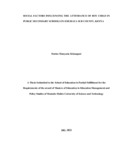| dc.contributor.author | Kisiangani, Dorine Munyasia | |
| dc.date.accessioned | 2024-01-22T13:15:17Z | |
| dc.date.available | 2024-01-22T13:15:17Z | |
| dc.date.issued | 2021-07 | |
| dc.identifier.uri | http://ir-library.mmust.ac.ke:8080/xmlui/handle/123456789/2613 | |
| dc.description | Masters of Education in Education Management and Policy Studies | en_US |
| dc.description.abstract | During Pre-colonial period a lot of emphasis was placed on the boy child education with almost no attention to the girl child. After independence, however, the government in a bid to address social injustice begun to emphasize on the importance of girl child education as a way of promoting gender balance. As a result of this, limited studies have been done on boy child education. This study therefore, examined social factors influencing the boy child school attendance in Emuhaya sub County. The study objectives were; to establish the influence of child labor on school attendance, to examine the influence of drug and substance use on boy child’s school attendance, to establish the influence of parental level of income on boy child’s school attendance, and finally to establish the influence of cultural initiation process on boy child’s school attendance. The education production function theory was adopted because it suggests that inefficiency in provision of schooling can lead to poor outcomes and hence poor school attendance. This study employed descriptive survey design. Emuhaya Sub County formed the study area because of the large number of youths below the age of 18 years who are neither trained nor completed school. The study population consisted of 6613 boys from 34schools that were both mixed and boys’ schools. From the population, the researcher sampled 280 students whereby 10 students from each school were sampled, a deputy principal from the 28 schools that were randomly sampled and a teacher of guidance and counseling was also purposively sampled so as to give reliable information. From the 28 schools, 10 students were purposively sampled because they are key to the study and the sample consisted of 3 form 4s, three form 2s, two forms 2s, and 2 form 1s all sampled according to their class performance. Both teachers in charge of guidance and counseling together with the deputy principals from each school were sampled. The instruments consisted of questionnaire for students, interview guides for teachers and a document checklist. Document checklist helped the researcher to obtain data on student school attendance and hence the dependent variable. Research instruments were validated using Cronbach alpha coefficient correlation value of 0. 887. Descriptive data was analyzed using both inferential and thematically by means and frequencies while quantitative data was analyzed by use of Pearson moment correlation so as to determine the relationship between dependent and independent variable. The findings established that boy child both in rural and urban are faced with multiple challenges that hinder their school attendance; drug and substance use greatly hinder boy child’s school attendance; there is high level of poverty in Emuhaya and also established that circumcision does not hold a cultural value within Emuhaya sub county. The views and outcomes of the study are instrumental to the education policy makers. | en_US |
| dc.language.iso | en | en_US |
| dc.publisher | MMUST | en_US |
| dc.subject | SOCIAL, ATTENDANCE, BOY CHILD, PUBLIC, SECONDARY SCHOOLS | en_US |
| dc.title | SOCIAL FACTORS INFLUENCING THE ATTENDANCE OF BOY CHILD IN PUBLIC SECONDARY SCHOOLS IN EMUHAYA SUB COUNTY, KENYA | en_US |
| dc.type | Thesis | en_US |

